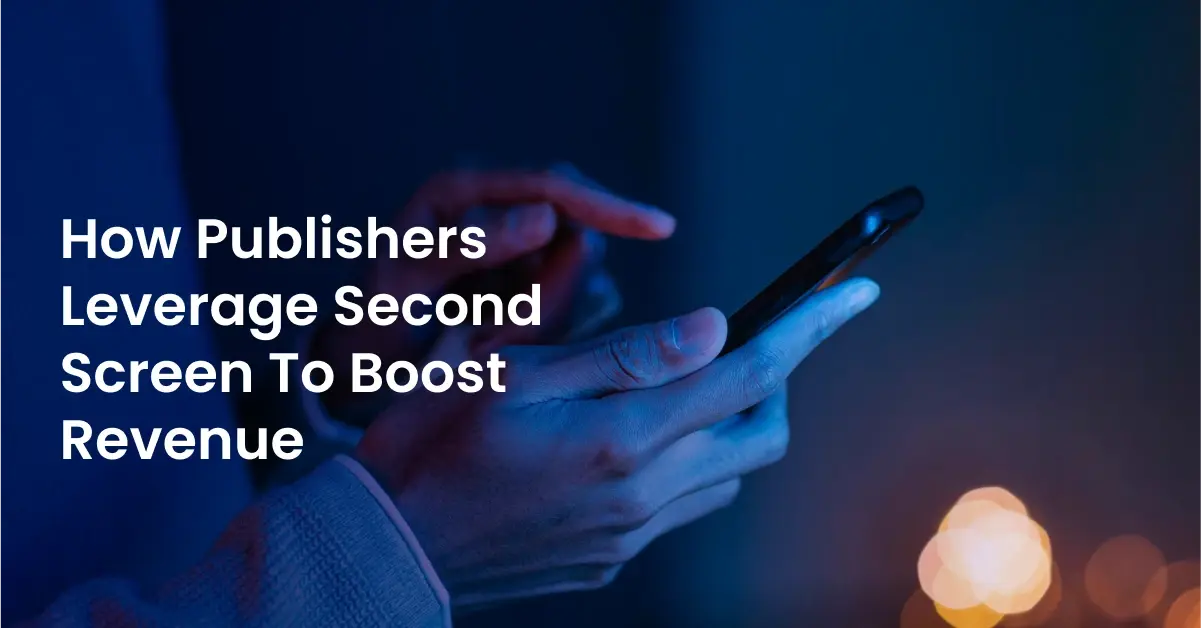



Second-screen experiences are fast becoming one of the most popular ways to interact with content. Viewers watch the main action on a TV and then use a second screen – like a phone – to chat with others about what they’re watching or find more information.
Providing a strong second-screen experience is a compelling way to lift engagement. Increasing engagement is a worthwhile goal. Yet, what if boosting revenue is your number one priority? Second-screen experiences can directly help you increase revenue.

Why Buying Broadcast Rights Isn’t The End of The Story
Buying broadcast rights, especially exclusive rights to marquee events like the Super Bowl or a hot HBO series, was a proven strategy. Exclusivity meant you were the only game in town for viewers, which helped to support high advertising rates. If you can afford such exclusivity, it’s a great strategy.
What if spending billions of dollars like Amazon for Thursday Night NFL football is out of the question for you? You can leverage a second-screen experience to piggyback on the popularity of a show or event. Content about an event – like a pre-game show in sports, red-carpet interviews at awards shows, and fan discussions – is proven to draw engagement.
All you need to get started is the right technology, like a live blog or live chat on your website, and something interesting to say! Fortunately, publishers live in a golden age of content creators and commentators. Almost every interest or category of pop culture today has influencers. So, invite a few influencers to participate in your live chat discussion.
Download our white paper “Generation Z and the Rise of the Second Screen” and transform your engagement strategy today.
4 More Ways Publishers Can Lift Revenue With Second-Screen Experiences
Once you start thinking creatively about second-screen experiences, there are five other powerful ways to lift revenue.
1) Increase Advertising Revenue With New Formats
Advertising revenue is the traditional key revenue source for major publishers. Having a second-screen strategy in place helps in two ways. First, second-screen experiences lift engagement, so you have more eyes on your content for longer. Second, second-screen experiences make innovative ad formats more effective.
Take interactive ads, for example. These types of ads are widely used on social media platforms like Facebook. Instead of passively viewing copy, images, and videos, an interactive ad lets the audience act. This can include taking direct action, like playing a mobile game or browsing different versions of a product (e.g., clothing size and color).
Interactive ads do some of the heavy lifting to convert a casual viewer into a potential customer. Therefore, publishers may charge higher rates to show this type of ad.
2) Direct Sponsorship

While related to traditional advertising, sponsorship deals are different. Typically, a sponsor will get a premium placement. You can offer the sponsor the opportunity to have a voice in the editorial process. For example, a sponsor may be interested in having one of their staff participate in an online event like a webinar or live chat session.
Look at the event industry for examples of what you can achieve with direct sponsorship. Major conferences like CES offer multiple sponsorship opportunities for brands like a spot in the conference daily’s publication (CES Daily) and the CES Tech Talk Podcast. The event also includes intimate scale sponsorships for the CTA Member Lounge and CTA Member Party.
Adding sponsorship revenue to your publication is generally easier if you offer a discrete, unique event. For example, a publisher might have a dedicated team covering early Presidential primary elections. Alternatively, a publisher can run virtual events and feature one or two sponsors.
There are some downsides to direct sponsorships to keep in mind. Brands may ask for some exclusivity, so your offering and pricing need to reflect that. Further, the best sponsorship deals require old-fashioned dealmaking instead of programmatic platforms. The good news is that a successful sponsorship has the potential to mature into an ongoing relationship and bring revenue for years to come.
The second-screen way to implement direct sponsorship is to focus on sponsorship for the secondary screen. It’s easier to design and package a second-screen experience like a live chat session on your website vs. making changes to a broadcast.
3) Subscriptions

Gaining more paying subscribers is one of the best ways to increase revenue in the long term. There are at least two ways to package subscriptions to appeal to the second-screen audience: premium add-on to existing subscriptions and creating a distinct subscription offering.
The premium add-on option is suitable for publishers with active digital subscribers. In this case, the approach is to offer an additional subscription option for second-screen users.
For example, you might offer pre-event and post-event coverage for significant business developments such as initial public offerings (IPOs). By limiting access to those with a specific subscription tier, the subscription also provides exclusivity. The potential to gain early information ahead of others is one way to attract an engaged audience, like investors, who thrive on valuable information.
What if you have no significant digital subscriber base? In that case, it’s vital to find more ways to distinguish your publication from other options on the market. Introducing a unique second-screen experience to your market may be the solution. For instance, your industry might not have a premium mobile app or mobile web experience available. In that case, a paid subscriber-only experience could stand out like a monthly event series.
4) Ecommerce

There are a few ways to increase e-commerce-related revenue using second-screen experiences.
Affiliate Marketing
In contrast, to display advertising, affiliate marketing is a new category. Thanks to major players like Amazon, eBay, and others, the affiliate marketing market is already generating billions of dollars. By using affiliate links, a publisher can earn a commission by recommending products.
The second-screen angle to affiliate marketing is to tie an affiliate marketing offer to something happening on the audience member’s primary screen. TV events with a significant celebrity presence – like the Emmys or Oscars – offer plenty of opportunities. For example, you might promote celebrity collectibles for sale at the high end (e.g., signed prints or posters) or lower-priced products (e.g., custom t-shirts produced at scale).
Affiliate marketing isn’t for every publisher, however. It best suits publishers reviewing, ranking, and discussing consumer products like the Wire Cutter.
Publisher Ecommerce
Some publishers have online stores selling apparel, accessories, back issues, and special prints. Selling more of their products – beyond traditional subscriptions – is another way to lift revenue.
To make your online store more appealing, look for ways to make a unique offering tied to a second-screen experience. For example, you might offer a discount code that leverages a plot point (e.g., the death of a character) in a significant streaming show. That kind of promotion has the virtue of being relatively simple to design and launch. The downside is that tying a promotion to an event like that has a short shelf life.
As you become more comfortable spotting and leveraging second-screen experiences, use several of these strategies in concert to keep growing.
The Indispensable Foundation For Second-Screen Revenue Growth
There are multiple ways for publishers to boost revenue by leveraging second-screen offers and experiences. All of these strategies rely on having a few core ingredients, like having a highly engaging website. Adding Arena Live Chat to your website is one of the best ways to make your website more interactive. Discover more about how to build a thriving online community right on your website.



